when the artist painted this piece, what circumstance was the artist trying to criticize in society?

- ane Introduction
- 1.1 Warhol & Pop Art
- 1.2 Andy Warhol & screen-press
- 2 Warhol'due south Marilyn Monroe portrait
- two.one The surprising meaning behind Warhol'south portrait of female superstars
- 2.2 Videos
- 2.three Original price & Worth & Auction records
- 2.4 Conclusion
Introduction
During his lifetime, Andy Warhol was e'er centrolineal with the notion of celebrity. It is often said that Andy Warhol understood the allure of global celebrity and its effects on contemporary order long before gossip blogs were even a thing. Even more than pointedly was his fascination with starlets, it-girls, and famous actresses of that time whom he would often immortalize in his now timeless artworks 1 .
Although Warhol'southward early piece of work focused on mail-war America's love affair with consumerism (which explains his obsession with Campbell's soup tins and Coca-Cola bottles), Warhol'due south most highly-priced pieces featured female person celebrities. By relying on his signature screen-press techniques to scribble over the iconic features of famous female faces, Warhol was responsible for making these celebrities even more pop fifty-fifty in death.
The most notable and obvious crowd-pleasers are apparently the Marylyn Monroe portraits. All the same, Warhol also featured other women such as Liza Minelli, Liz Taylor, Debbie Harry and Joan Collins in his artworks 2 . It was in Studio 54, the ultimate Manhattan nightclub that made headlines during the 1970s, that Warhol found many of his celebrity sitters. Still, none were e'er every bit famous or every bit seemingly of import every bit Marylin Monroe was to Andy Warhol and his career.
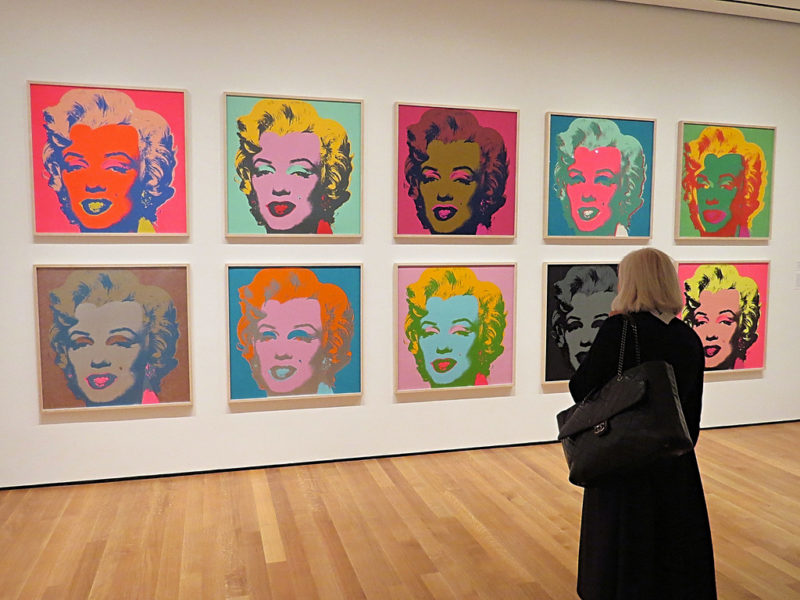
Warhol & Popular Art
Warhol'south Marilyn Diptych exemplified everything that Pop fine art was, thank you to its explicit reference to Marilyn Monroe, who was an icon of popular civilisation. Pop fine art started its movement in London thank you to an contained group of artists attracted to advertisements that depicted American mass culture and materialism. In this regard, everything mass culture, whether music, ads or trip the light fantastic toe became the primary discipline of British pop 3 art. Warhol's Marilyn Diptych would therefore not take existed without British pop art to inspire information technology.
Warhol's depictions of women and starlets explored the relationships between consumer society, fashion, fame, sensationalism and death. It is as well said that through his distinctive mode of work, Warhol referred to a society in which individuals were seen equally mere products rather than human beings.

Andy Warhol & screen-press
Andy Warhol was a major figure in art. It is because of Andy Warhol and his contributions to fine art that the world is still fascinated by pop and modern art styles. Andy Warhol has become such a mainstay of modern art that in 2013, one of his pieces sold for 105 million dollars 4 at a Sotheby'southward auction.
Born to Slovakian immigrants, Andy did not have a normal babyhood. He suffered from Sydenham's chorea, which caused a host of medical bug that would often force Warhol to miss schoolhouse. As a kid, Andy was often away from his friends and was thus heavily influenced by his stylistic choices and personality. His style was further impacted by the people he saw on Tv. Still, it was non until he joined the Carnegie Institute of Technology that commercial fine art (promotions and advertisements) started to straight his work.
The print screening 5 was an integral feature of Warhol'south manner. It mainly involved using mesh screens to transfer ink onto the canvas, leaving the areas that had been stenciled out without ink. He would repeat this procedure using different colors and stenciling patterns several times until he had fully saturated the sail.
Andy Warhol, along with other commercial artists, was addicted of using this technique as information technology was the most effective way of producing mass prints long before laserjet printers came into view. Screen printing divers Warhol'southward style and career; he rarely used whatsoever other medium in his work. He also applied this manner to the recognizable prints, 'Marilyn', which he created as an intense reflection of his thoughts towards celebrities and other social figures.
Just as Warhol's fetishistic use of consumer-produced packaging was often the source of many debates and discussions, so was his obsessive rendering of famous females. Warhol loved women. Every bit a gay man, he appeared to appreciate their grade more than other artists in his circles, and he chose to value these women past turning them into icons of beauty and sophistication.
Considering in that location was something otherworldly about celebrities like Liza and Marilyn, Warhol e'er wanted his women to look like truthful beauties. As such, in that location were never under eye circles, whatever acne, or whatever furrowed 6 foreheads for his beauties as he had to present them as order saw them (perfectly) in his silkscreens.
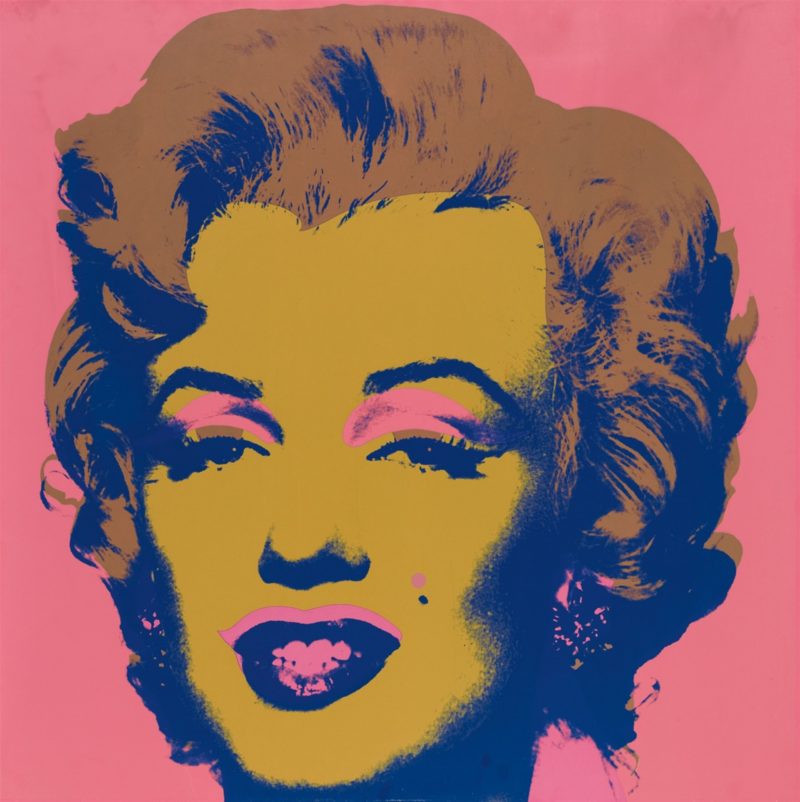

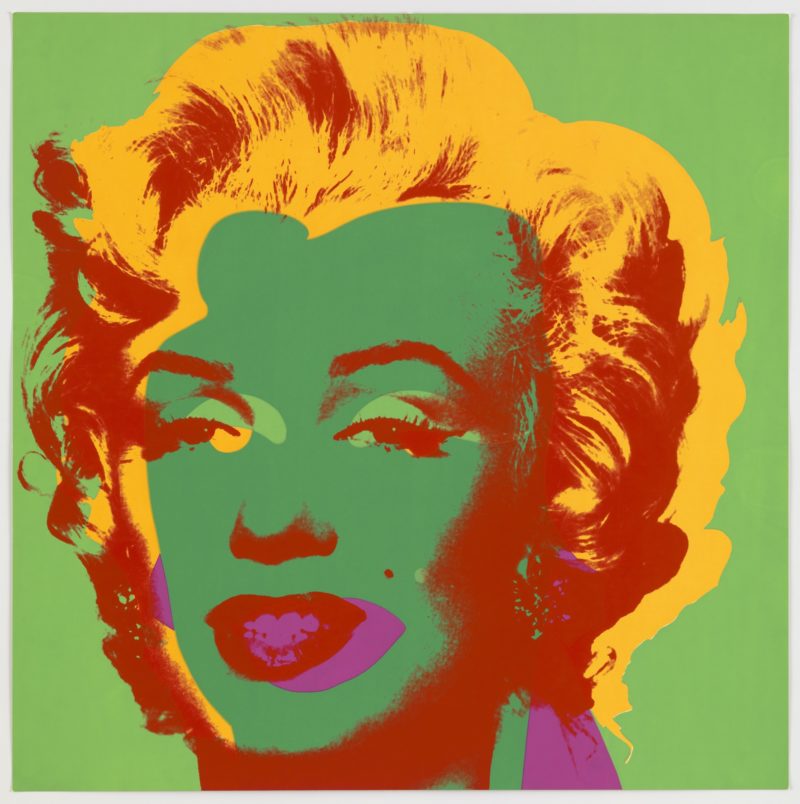
Warhol's Marilyn Monroe portrait
Marilyn Monroe was and still remains one of the biggest sex symbols of all 7 fourth dimension. When she was alive, her personal life was more than interesting than her professional i. She had already been married several times. Like many of her fans, Warhol had become fascinated by the thought of popular figures such equally Monroe who lived unimaginably glamorous lifestyles and who had attained an about mythical status as Hollywood icons.
It was pure coincidence that Warhol chose Monroe to feature in his earliest and possibly most famous works of pop art. Although she had already ended her life at the fourth dimension of the painting, her face and her fame provided Warhol with an excellent basis for his repetitive print and animation-like work in the futurity.
As stated to a higher place, Warhol'southward photographic silkscreen printing had already come up of historic period by 1962 and had fifty-fifty started to go his defining style. Warhol fifty-fifty considered retiring from painting 8 altogether. For his Marilyn portrait, Warhol portrayed the famous motion-picture show star from a publicity photo that he knew most nobody would recognize from the Moving picture Niagara, which was released in 1953, rather than draw an epitome of her face or paint it. Warhol'south Marilyn Diptych was created from 2 argent canvases on which Warhol silkscreened a moving picture of Monroe 50 times.
In his Marilyn Monroe series, contrary to normal expectations, Warhol created the Monroe diptych by painting the canvas first using different colors 9 before he screened the now-famous image of Marilyn on tiptop of the canvas. The misregistration of the screen-impress and painting resulted in a dynamic surface that he then enhanced using a spectrum of colors.
This deed of printing and painting in several variations immune Warhol to play and explore the range of graphic possibilities that that single image of Marilyn could produce. Warhol demonstrated his extraordinary employ of colour by adding day-glow colors and metallic paints that were not ordinarily found in gimmicky art, which farther helped information technology stand out.
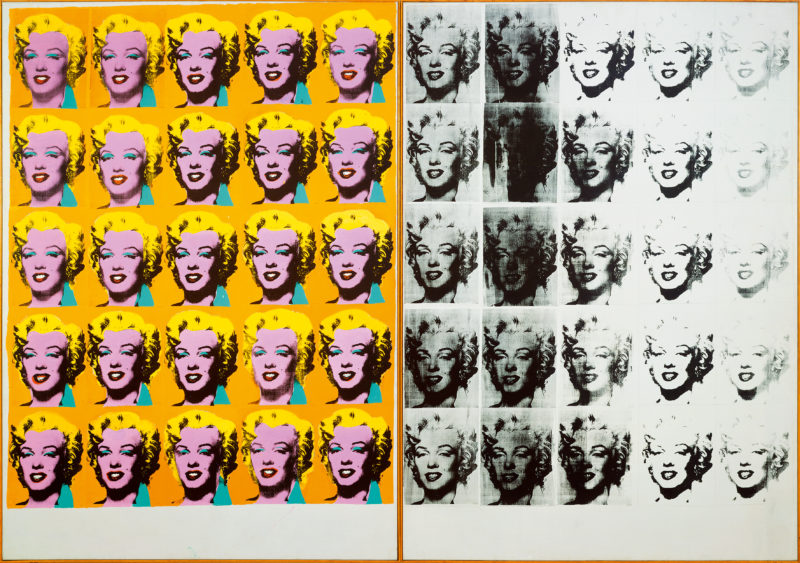

The surprising meaning behind Warhol'southward portrait of female superstars
The 5 rows of the diptych resemble the movielike strips that acknowledge her condition equally an icon. The repetition of her epitome symbolized mass production, while the diptych style used in the portrait was inspired by the Byzantine icons of Christian saints. By placing Marilyn Monroe's portraits in the diptych, Warhol was commenting on the saint-like nature that fans assign celebrities, which in turn causes the public to approach celebrities with some sense of holiness and immortality.
Of course, the images of his female sitters are amongst Warhol's most hit, and they grade a considerable body of his piece of work. Many take chosen his series of female glory portraits reductive and anti-feminist because of his emphasis on his subjects' lips, hair, and eyeshadow, making them announced one-dimensional and superficial as people, fifty-fifty when they are anything but.
Although deeply fascinated by their professional lives, Warhol was also merely equally interested in the struggles and suffering these women endured behind their painted-on smiles. Case in point, Warhol painted Marilyn just two weeks after she had committed suicide. In his other piece, Liz Taylor was created when she was gravely ill x . On the other hand, Red Jackie was painted after JFK'south death while another one, Blue Jackie utilized an paradigm from the funeral.
Warhol's art was created to remind audiences and fans that in that location is actually a real person behind all the fame and glamour. Perhaps he wanted to describe that these famous women were regular human beings who experienced pain and suffering, despite their celebrity.
This diptych tin can as well be said to have been a celebration as well every bit a satire of the world's obsession with materiality and fame. It was both worship and analysis that criticized and encouraged a culture that had get obsessed with money and fame. At the same time, Warhol too used Marilyn to criticize himself, as he was also after the same fame and celebrity that his famous subjects enjoyed.
Although he was careful to conceal his religion throughout his career, it is believed that the Marilyn Monroe diptych was also explicitly religious: Marilyn Monroe appears in the canvas every bit a superhuman and is near saintly-like. Therefore, Marylin was used to represent a martyr that has to this twenty-four hours remained unchanged and immaculate fifty-fifty every bit the rest of contemporary society continues to rot and waste away.
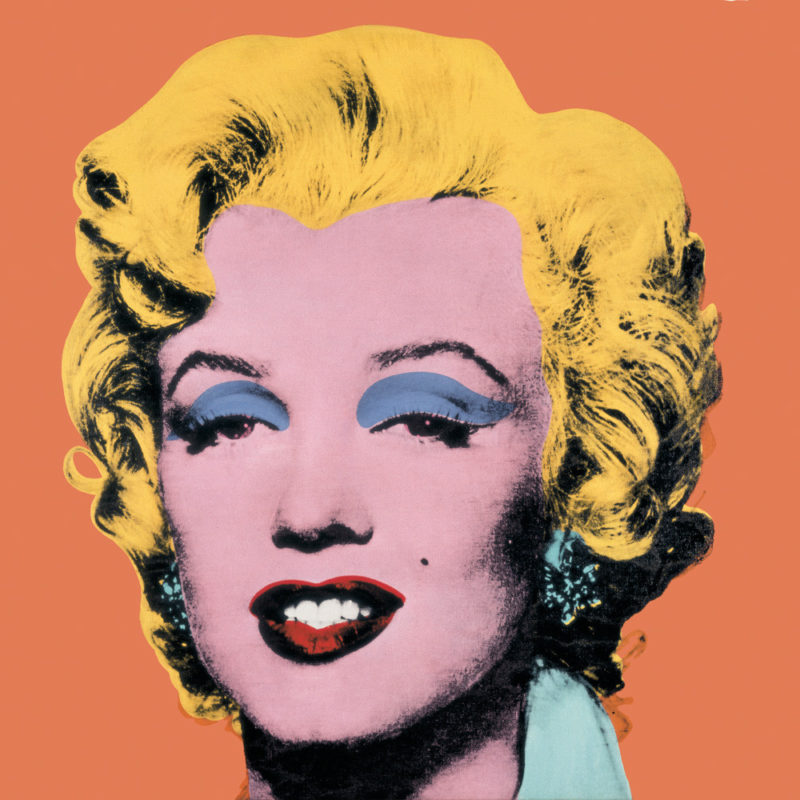
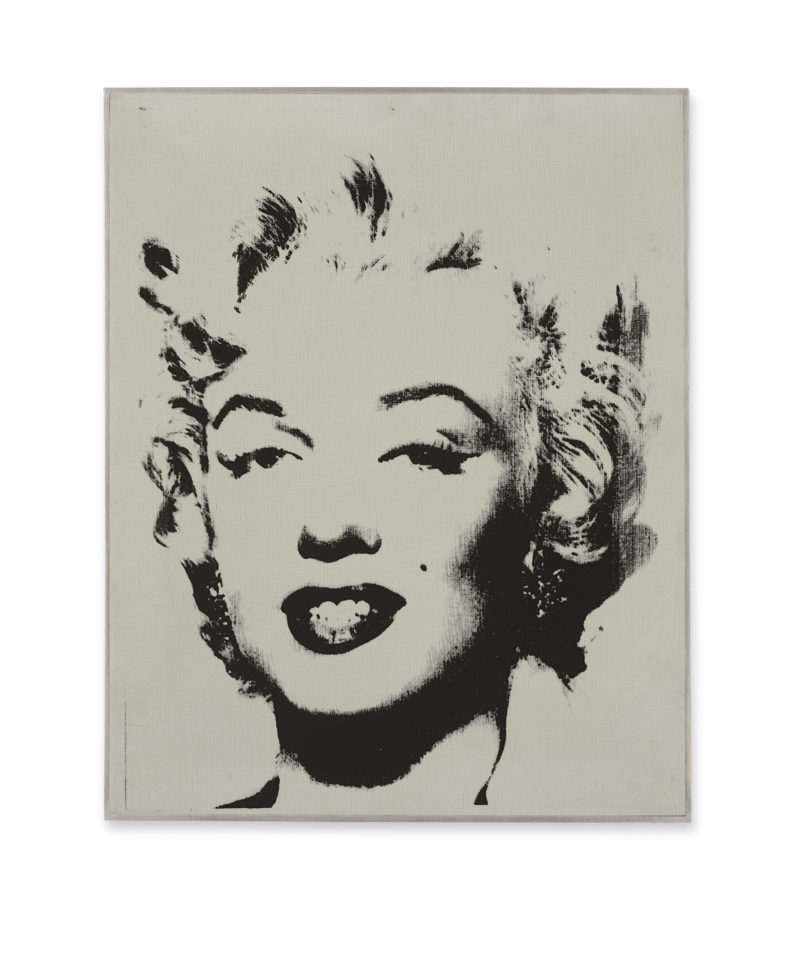
Videos
Zach Miner of Phillips about Four Marilyns, 1962
2 min
Christie'due south about Four Marilyns, 1962
2 min xx sec
Andy Warhol'due south Marilyn Diptych at Tate Modern
2 min vii sec
Original price & Worth & Auction records
Warhol produced xiii almost identical portraits of Marilyn Monroe, each with a dissimilar colored background for his first one-person exhibition. In November 1962, three months after Marilyn Monroe passed away, these works sold for $250.
On May xiv, 1998, Orange Marilyn was auctioned at Sotheby'south evening sale of contemporary fine art. Estimated at $4-6 million, information technology set a new record at $17.3 million for the highest cost paid for a Warhol 11 .
On May 16, 2007, Lemon Marilyn sold for USD 28,040,000 at Christie's 12 , 112,160 times its original price.
On May 13, 2014, White Marilyn, 1962 sold for $41 meg at Christie'south 13
Decision
When the audience and the public needed to see the modern world they had created through new eyes, Warhol was e'er ready to engage in honest representation and assessment. Indeed, the earth'south obsession with Marilyn Monroe has never wavered and information technology is almost as though Warhol could encounter into the future. If he was here today, who knows who he would have opted to focus on? With socialites ruling the twenty-four hours today, the likes of Kim Kardashian would take made great subjects for Warhol.
All images: The Andy Warhol Foundation for the Visual Arts, Inc. / Artists Rights Club (ARS), New York unless otherwise noted.
Footnotes
- https://www.telegraph.co.uk/culture/8591604/Warhols-women.html
- https://www.stylist.co.uk/people/warhol-and-his-women/15643
- https://arthistoryoftheday.wordpress.com/2011/08/16/andy-warhol-marilyn-diptych-1962/
- https://medium.com/@winston_willett/the-influence-of-andy-warhol-on-abstract-expressionism-59d633f61b5f
- https://hamiltonselway.com/andy-warhols-silk-screening-process/
- https://www.telegraph.co.uk/culture/8591604/Warhols-women.html
- https://www.hollywoodreporter.com/gallery/marilyn-monroe-death-50-yr-anniversary-pictures-358278
- https://publicdelivery.org/andy-warhol-argent-clouds/
- https://hamiltonselway.com/andy-warhols-silk-screening-process/
- https://theculturetrip.com/north-america/canada/articles/andy-warhols-globe-of-celebrity/
- https://www.nytimes.com/1998/05/15/arts/17.3-million-marilyn-sets-tape-for-warhol.html
- https://world wide web.christies.com/lotfinder/Lot/andy-warhol-1928-1987-lemon-marilyn-4913710-details.aspx
- https://www.christies.com/lotfinder/Lot/andy-warhol-1928-1987-white-marilyn-5792524-details.aspx
Source: https://publicdelivery.org/andy-warhol-marilyn-monroe/
0 Response to "when the artist painted this piece, what circumstance was the artist trying to criticize in society?"
Post a Comment